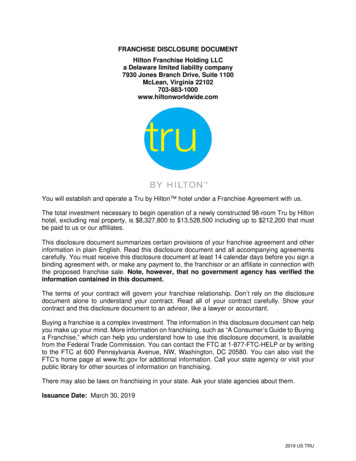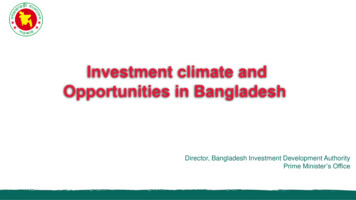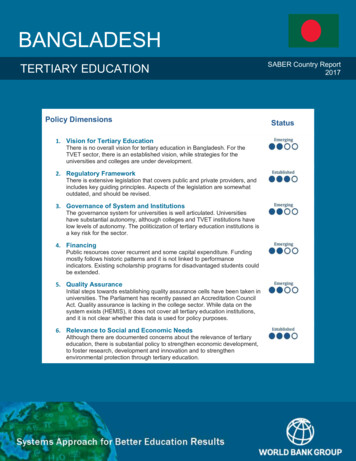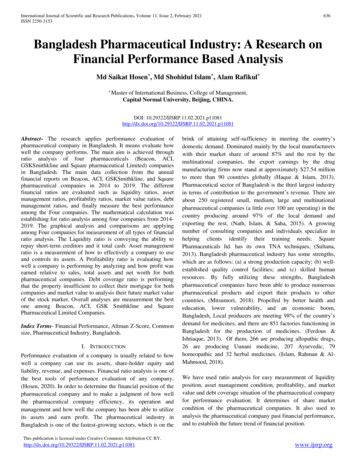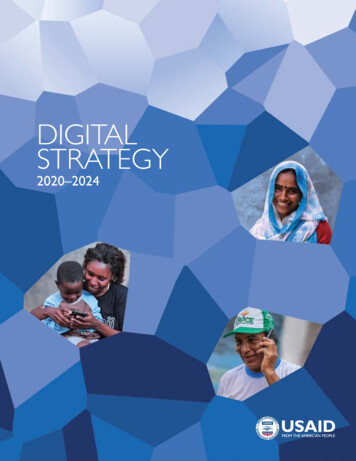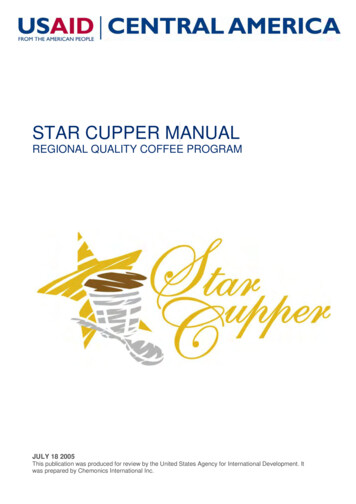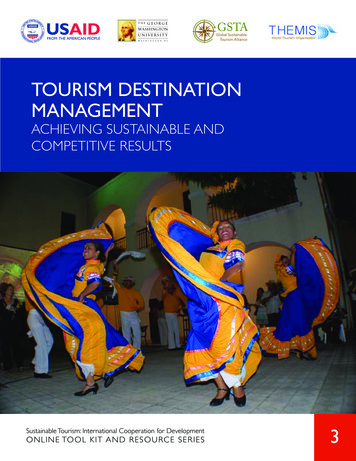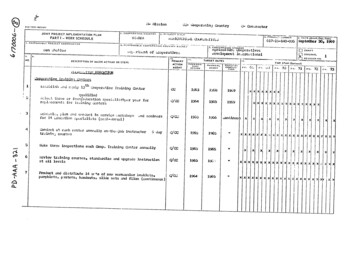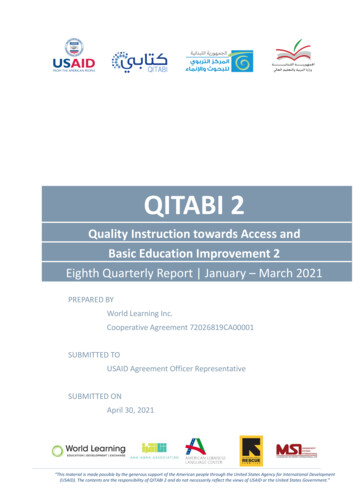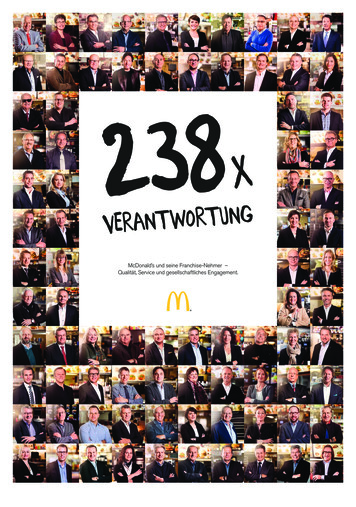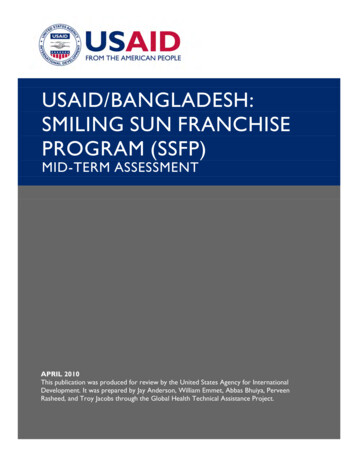
Transcription
USAID/BANGLADESH:SMILING SUN FRANCHISEPROGRAM (SSFP)MID-TERM ASSESSMENTAPRIL 2010This publication was produced for review by the United States Agency for InternationalDevelopment. It was prepared by Jay Anderson, William Emmet, Abbas Bhuiya, PerveenRasheed, and Troy Jacobs through the Global Health Technical Assistance Project.
USAID/BANGLADESH:SMILING SUN FRANCHISEPROGRAM (SSFP)MID-TERM ASSESSMENTDISCLAIMERThe authors’ views expressed in this publication do not necessarily reflect theviews of the United States Agency for International Development or the UnitedStates Government.
This document (Report No. 10-01-342) is available in printed or online versions. ryatwww.ghtechproject.com/resources. Documents are also made available through theDevelopment Experience Clearing House (www.dec.org). Additional information can beobtained from:The Global Health Technical Assistance Project1250 Eye St., NW, Suite 1100Washington, DC 20005Tel: (202) 521-1900Fax: (202) 521-1901info@ghtechproject.comThis document was submitted by The QED Group, LLC, with CAMRIS International and Social& Scientific Systems, Inc., to the United States Agency for International Development underUSAID Contract No. GHS-I-00-05-00005-00.
CONTENTSACRONYMS . iiiEXECUTIVE SUMMARY . vEstablishing the Franchise. vDeclining USAID Costs . viIncreased Service Provision . viSummary Recommendations . viiI.INTRODUCTION. 1II.BACKGROUND. 3III.OUTCOME 1: THE SMILING SUN FRANCHISE . 5A.Establishing the Franchise . 5B.Appropriateness of the Franchise Model . 12C.SSFP Relationships with NGOs, the MOH, USAID, and Other Partners . 15IV. OUTCOME 2: CONTINUED SERVICE DELIVERY WITH DECLININGUSAID FUNDING . 17A.Contract Budget and Burn Rate . 17B.Program Income from NGOs (USAID Program Income) . 18C.NGO Use of Funds . 19D.Program Income from “Strategic Partners”. 19V.OUTCOME 3: INCREASED CLIENT VOLUME, COVERAGE OF THE POOR,RANGE OF SERVICES, AND QUALITY OF CARE . 21A.Client Volume . 21B.Coverage of the Poor. 24C.Range of Services. 24D.Communication Activities . 25VI.BEST PRACTICES . 27VII.LESSONS LEARNED. 29VIII. RECOMMENDATIONS . 31ANNEXESANNEX 1. SCOPE OF WORK . 33ANNEX 2. LIST OF DOCUMENTS REVIEWED. 43ANNEX 3. SSFP MID-TERM ASSESSMENT LIST OF PERSONS CONTACTED . 47USAID/BANGLADESH: SMILING SUN FRANCHISE PROGRAM MID-TERM ASSESSMENTi
FIGURESFigure 1. Smiling Sun Franchise Program Staffing Plan. 7Figure 2. SSFP Progress toward Establishing a Sustainable Franchise (as of April 2010) . 11Figure 3. Map of SSFP Catchment Areas . 22TABLESTable 1. Percent of Total Urban and Rural SSFP Clinics by Percent Cost Recovery by Year . 14Table 2. Smiling Sun Franchise Program: Budget . 17Table 3. Program Income . 18Table 4. Projected Use of Available Program Income. 19Table 5. Program Income from Strategic Partners . 19Table 6. SSFP Achievement of Year 2 PMP Target on Selected Clinical andManagement Indicators . 21Table 7. Smiling Sun Franchise Program Mid-Term Assessment . 32iiUSAID/BANGLADESH: SMILING SUN FRANCHISE PROGRAM MID-TERM ASSESSMENT
ACRONYMSANCAntenatal careARIAcute respiratory infectionBATBBritish American Tobacco (Bangladesh)BCCBehavior change communicationBCCPBangladesh Center for Communication ProgramsCACooperating agencyCADMComprehensive approach of diarrhea managementCDDControl of diarrheal diseasesCBSGCapacity Building Services GroupCSPCommunity service providersCWFDConcerned Women for Family DevelopmentDOTSDirectly Observed Treatment, Short-courseDPTDiphtheria, pertussis, tetanusEPIExpanded Programme for ImmunizationsESDEssential service deliveryFDFFranchise development fundFGDFocus group discussionFMOFranchise manager organizationFP/RHFamily planning/reproductive healthGH TechGlobal Health Technical Assistance ProjectGOBGovernment of BangladeshICDDR, BInternational Centre for Diarrhoeal Disease Research, BangladeshIMCIIntegrated management of childhood illnessLAPMLong-acting and permanent methodsMISManagement information systemsMOHMinistry of HealthMOHFWMinistry of Health and Family WelfareNGOsNongovernmental OrganizationsNSDPNGO Service Delivery ProgramPIProgram incomePMPPerformance monitoring planPNCPrenatal careRSDPRural Health Services Delivery ProgramUSAID/BANGLADESH: SMILING SUN FRANCHISE PROGRAM MID-TERM ASSESSMENTiii
SSFPThe Smiling Sun Franchise ProgramTBTuberculosisTOTTraining of trainersTPMTeam planning meetingUFHPUrban Family Health PartnershipUSAIDThe United States Agency for International DevelopmentUSGUnited States GovernmentivUSAID/BANGLADESH: SMILING SUN FRANCHISE PROGRAM MID-TERM ASSESSMENT
EXECUTIVE SUMMARYThe Smiling Sun Franchise Program (SSFP) is the United States Agency for InternationalDevelopment (USAID)/Bangladesh’s largest health initiative; it is the latest in a series ofprograms going back to at least 1998 that have sought to improve the ability of local nongovernmental organizations (NGOs) to provide basic health services to the poor. Implementedunder a contract between USAID and Chemonics International, SSFP works with 28 NGOs thatoperate 320 clinics and 8,500 satellite (outreach) sites in urban and rural areas nationwide inBangladesh. Designed in 2007 when the mission was told that its funding for health care woulddecline drastically, SSFP was intended to prepare these NGOs for the withdrawal of USAIDsupport. Although SSFP and its predecessors have both emphasized quality of care and programmanagement, only the former made financial sustainability its principal priority.Sustainability is pursued through user fees and development of a franchise under which NGOclinics are to be licensed to use the Smiling Sun brand—developed under a previous program—to promote themselves as sources of quality care for which clients will pay. Smiling Sun clinicsstress the courteous provision of standardized services in attractive settings, with supervisionand assistance from a franchise management organization (FMO). By the end of the program,revenue from paying clients and/or third-party payers is expected to finance service provision byNGOs, including free or discounted services for the poor as well as long-term operation of theFMO. Service provision is expected to increase while USAID’s costs decline. These objectivesare embodied in three desired outcomes in USAID’s contract with Chemonics: establishmentof a franchise, declining USAID cost, and increasing service provision, including a greater numberof services to the poor. This assessment reports on progress in attaining these outcomes as ofApril 2010.ESTABLISHING THE FRANCHISEProgress in establishing an effective, sustainable franchise was assessed in terms of 10 criteriaderived by one of the assessment team’s five members. In addition, the literature on socialfranchising for health was reviewed, as was SSFP’s progress in cost recovery, to estimate thelikelihood that the program’s financial sustainability objective could be attained. The teamconcluded that there has been only limited progress in establishing a franchise. Problems haveincluded recruitment and retention of qualified staff; insufficiently targeted and at times poorlyexecuted training; a nonfunctional franchise board of directors; insufficient attention tomarketing and communication; and inadequate buy-in to the franchise concept by NGOs, whichsee it as imposed by USAID and do not perceive benefits from membership equal to theeventual cost thereof. Although SSFP has a reputation for quality services and its managementinformation system (MIS) is superior in terms of data provision, quality-assurance andsupervision activities often are largely pro forma, and problems persist in the use of data.International experience suggests that establishing a viable franchise is a long-term task, and itwas perhaps unreasonable to expect Chemonics to accomplish it completely in the four yearsallotted for SSFP. But time aside, both international experience and SSFP’s record in costrecovery to date indicate that, franchise or no franchise, it is not feasible to recover throughuser fees the costs of (i) a FMO, (an eventual substitute for technical assistance provided byUSAID) and (ii) a service-delivery program focused on the poor (financed by USAID). Theassessment team believes that the design of SSFP, prompted primarily by USAID budgetimperatives, was fundamentally flawed in this respect.USAID/BANGLADESH: SMILING SUN FRANCHISE PROGRAM MID-TERM ASSESSMENTv
DECLINING USAID COSTSUSAID’s costs for service-delivery have not declined during the first two years of the program.Rather, they have increased and seem likely to rise further by the end of the program. USAID isplanning a detailed audit to determine reasons for the increase, but Chemonics stated that itwas caused by inflation, the need to raise salaries to retain qualified staff, and insufficientrevenues to cover these costs. SSFP has secured (or retained from previous programs) nonUSAID funding from three private companies and a local philanthropy, but these monies largelysupport services for new clients and have little effect on USAID’s costs.INCREASED SERVICE PROVISIONThe program has increased the volume of services provided, especially recently. Service contactsare up overall, with the use of family planning and postpartum visits increasing substantially.However, it is unclear whether the increased volume of services provided by SSFP translatesinto a greater market share for the program.However, there are significant missed opportunities for service provision, including some majorcauses of preventable mortality: childhood pneumonia, unsafe deliveries, and poor newborncare. In addition, the lack of postabortion care in Bangladesh is unaddressed by SSFP. Althoughcollaboration has been discussed with Engender Health’s Mayer Hashi program to increase theuse of long-acting and permanent methods (LAPM) for family planning, and training has beenprovided for service providers, LAPM use remains chronically low in SSFP and elsewhere inBangladesh. Ministry of Health (MOH) policy that SSFP-diagnosed cases of tuberculosis (TB) betreated in government facilities may result in cases lost to treatment. Furthermore, theindicators used to measure progress in service delivery are modest, and clinic catchment areas,inherited from previous programs rather than planned by SSFP, are small and often overlap withgovernment health facilities. Despite the program’s national presence, the above factorsprobably place significant limits on its national public health impact.SSFP reports that about 26% of its service contacts are with poor people — a percentage thatseems to be increasing and compares positively with other social franchising programs.However, this finding results from actions of previous programs rather than a specific SSFPstrategy for reaching the poor, and it does not indicate that SSFP serves 26% of the poorpopulation in its catchment areas. It is doubtful that SSFP can cover a substantial portion of thispopulation while also attaining its objective of 70% cost recovery (a figure still 30% shy of actualself sufficiency).Although overlap with government facilities may result in a larger percentage of the poorpopulation served than can be served by SSFP alone, it is unlikely the program can cover asubstantial percentage of the poor while attaining the 70% cost recovery.In addition to increasing “client volume” (the number of clients) the Chemonics contract callsfor a rise in the “range of services.” The meaning of this phrase is not specified, but, accordingto USAID, it refers to the number of SSFP clinics. The program has added three clinics and 87satellite sites since its inception. The assessment team believes that the emphasis on outreachsites as opposed to fixed facilities is appropriate, given the views of staff and stakeholders thatpeople are more likely to use services available near their homes. The team believes SSFP’soutreach should be extended to encompass non-medical providers such as “village doctors,”drug sellers, and traditional birth attendants. As no plan for using revenues (program income[PI]) has been approved, USAID to date has neither agreed to add 10 clinics nor accepted aproposal to expand safe delivery or emergency obstetric care, aside from upgrading a few clinicsto enable provision of these services.viUSAID/BANGLADESH: SMILING SUN FRANCHISE PROGRAM MID-TERM ASSESSMENT
Although marketing efforts seem central to increasing service utilization and revenue,communication activities have been limited under SSFP—in terms of promotion of Smiling Sunclinics generally and for specific services (e.g., LAPM, child pneumonia, safe deliveries, andnewborn care). The program has emphasized inexpensive local clinic-promotion campaignslargely designed, implemented, and funded by the NGOs. It does not have experiencedcommunication staff or a coherent communication strategy and has made haphazard use of acapable local communication agency (developed with substantial prior USAID investment).While the team does not believe that SSFP’s communication activities have been particularlyeffective, there are no data on the influence of these efforts on service utilization.The assessment team identified best practices and lessons learned and made 11recommendations to USAID for improving the program in its final 17 months. The latter aresummarized as follows.SUMMARY RECOMMENDATIONS1. Cease further efforts to establish the Smiling Sun franchise.2. Instead, create an NGO Consortium governed by the NGOs, which would own the SmilingSun brand, establish their own priorities, and cost-recovery targets based on thesepriorities, and liaise with donors and government to secure additional funds and technicalassistance.3. Continue to work with NGOs on cost recovery and business planning, but without the 70%cost-recovery target and with increased emphasis on nonfinancial aspects of programsustainability.4. Increase emphasis on conditions responsible for sizeable portions of preventable mortality(childhood pneumonia, safe deliveries, and newborn care) and on long-term family planning.5. Secure professional expertise to strengthen communication activities in line with a newMOH communication strategy and with renewed emphasis on family planning (especiallylong-acting methods), childhood pneumonia, safe deliveries, and newborn care.6. Provide NGO staff with the commodities they currently use informally in home deliveries,and track these deliveries and their outcomes in the program’s MIS.7. Assess the technical and management-development needs of individual staff and provideneeds-based training as indicated.8. Maximize NGOs’ outreach capacity to the poor by (i) re-directing support for costineffective clinics in rural areas so that they operate more as hubs for increasing the numberof satellite sites and (ii) linking these sites with “village doctors,” drug sellers and traditionalbirth attendants.9. Explore potential NGO management of MOH community clinics in areas where the MOH ishaving difficulty opening these facilities.10. Use SSFP’s MIS and GIS capability with the MOH to eliminate service-delivery redundanciesand gaps in areas where SSFP clinics are located.11. Revise program structure and job descriptions to implement the above recommendations.USAID/BANGLADESH: SMILING SUN FRANCHISE PROGRAM MID-TERM ASSESSMENTvii
viiiUSAID/BANGLADESH: SMILING SUN FRANCHISE PROGRAM MID-TERM ASSESSMENT
I.INTRODUCTIONSSFP provides family planning, maternal, newborn, and child-health services in urban and ruralareas in 61 of Bangladesh’s 64 administrative districts. It is funded under a contract betweenUSAID/Bangladesh and Chemonics International, which provides technical assistance and subgrants to 28 local NGOs. These NGOs operate 320 static clinics (286 “vital” clinics offering abasic service package and 34 “ultra” clinics that add emergency obstetric care) andapproximately 8,500 satellite clinics held one or more days/week by rotating staff. The NGOsdeploy approximately 7,000 paid staff plus about 6,200 volunteer community service providers(CSPs), or community mobilizers/health educators and providers of family planning and a fewother basic commodities. The program began October 1, 2007 and is scheduled to endSeptember 30, 2011.At USAID/Bangladesh’s request, four consultants recruited by the GH Tech Pro
The Smiling Sun Franchise Program (SSFP) is the United States Agency for International Development (USAID)/Bangladesh’s largest health initiative; it is the latest in a series of programs going back to at least 1998 that have sought to improve the ability of local non-governmental organizat
